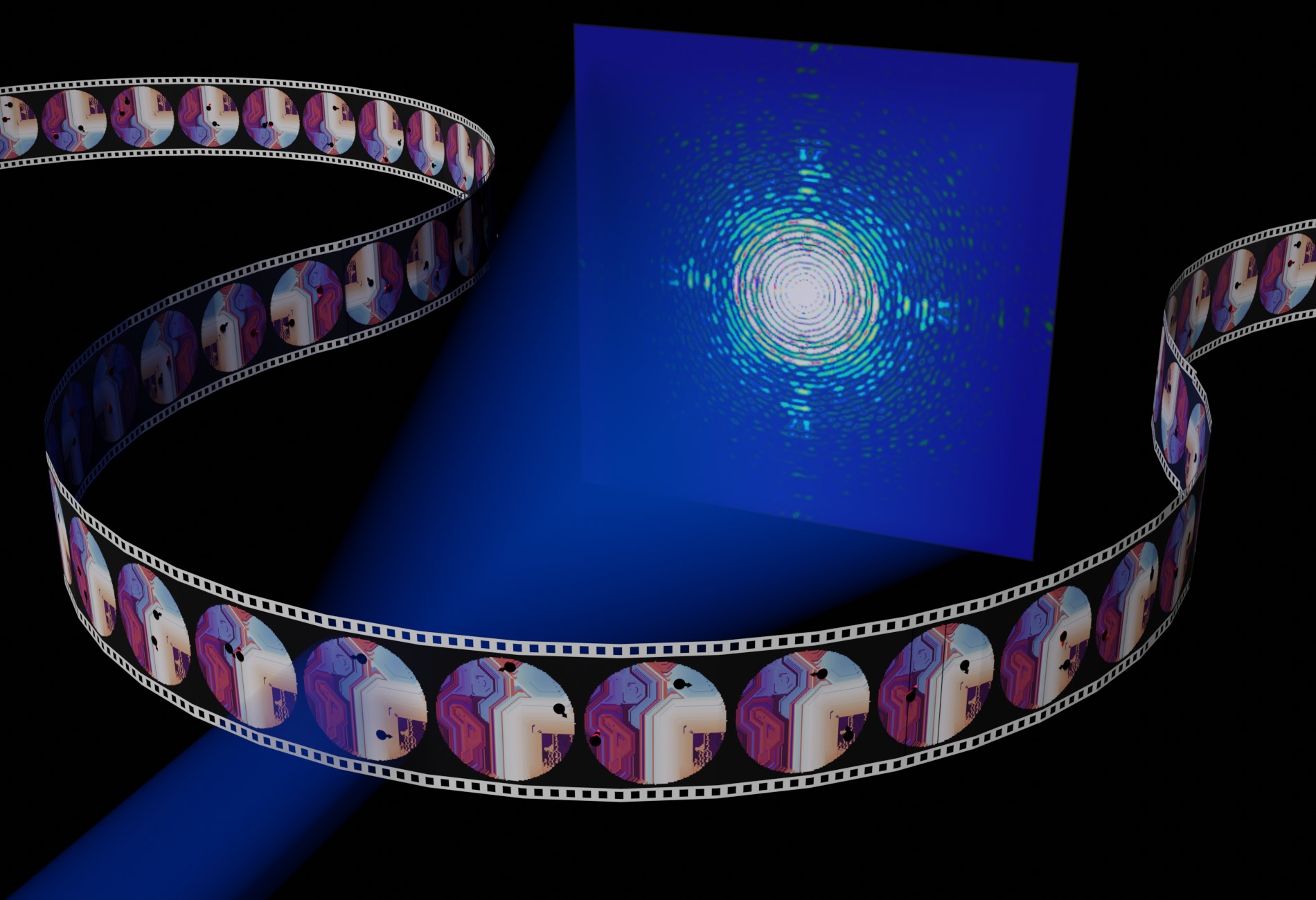A new method captures the stochastic dynamics in coherent X-ray imaging
04.09.2024
 |
|
Multiple snapshots reveal, through a X-ray diffraction pattern, the features of an ultrafast stochastic process. Credit: Arnab Sarkar and Allan Johnson. |
- IMDEA Nanociencia researchers demonstrate a new approach to return real space images of stochastic processes at the nanoscale currently unobtainable with existing approaches, through X-ray imaging.
- This method would allow the imaging and study of ultrafast processes avoiding the use of large X-ray fluxes which potentially damage samples.
- The method does not necessarily require the use of ultrashort X-ray pulses, opening the possibility of imaging femtosecond processes using broadband continuous wave radiation.
| Tweet |
Madrid, 4th September, 2024. Coherent X-ray imaging has emerged as a powerful tool for studying both nanoscale structures and dynamics in condensed matter and biological systems. The nanometric resolution together with chemical sensitivity and spectral information render X-ray imaging a powerful tool to understand processes such as catalysis, light harvesting or mechanics. Unfortunately these processes might be random or stochastic in nature. In order to obtain freeze-frame images to study stochastic dynamics, the X-ray fluxes must be very high, potentially heating or even destroying the samples. Also, detectors acquisition rates are insufficient to capture the fast nanoscale processes. Stroboscopic techniques allow imaging ultrafast repeated processes. But only mean dynamics can be extracted, ruling out measurement of stochastic processes, where the system evolves through a different path in phase space during each measurement. These two obstacles prevent coherent imaging from being applied to complex systems.
Dr. Allan Johnson, leader of the Ultrafast Science of Quantum Materials Group at IMDEA Nanociencia, together with Dr. Arnab Sarkar, have conceived a new method to directly recover the signal in a wide variety of systems currently unobtainable with existing approaches. The researchers have shown that, leveraging the coherence intrinsic to these methods, it is possible to separate out the stochastic and deterministic contributions to a coherent X-ray scattering pattern, returning real space images of the deterministic contributions, and the momentum spectrum of the stochastic contributions.
Stochastic processes are widespread at the nanoscale, where thermal or quantum effects become highly significant. For instance quantum materials often show stochastic motion of charge carriers, vortices or domain walls. Because of the difficulty in forming real space images of such stochastic processes, fluctuations are generally studied through alternative methods that return the statistical properties. Single-shot measurements, performed at free electron lasers, could allow snapshots of fluctuations, although may not be possible in many systems due to damage concerns. Recently, coherent correlation imaging has been used to group similar frames in repeated measurements until the signal-to-noise is sufficient to reconstruct real images. This technique is a major methodological advance, but still requires enough flux in order to ensure the partial frames acquired are sufficiently complete.
In their work, recently published in Materials Advances, IMDEA Nanociencia researchers have demonstrated a new approach for separating the stochastic and deterministic (mean) contributions in coherent imaging methods. From averaged diffraction pattern of multiple snapshots, researchers show that it is possible to isolate the stochastic part through a Fourier transform holography analysis. They have demonstrated they can return real space images of the mean fluctuations in three representative test cases: uncorrelated point-like defects (vortices), polaron-like pairs, and metallic domain walls in an insulating matrix. By applying reconstruction methods to the scattering patterns, researchers returned a range of quantitative information: separation, size and phase shift of the polaron pairs, and size, shape, and metallic character (spectral dependence) of the domain walls.
There are many more examples of fluctuations at the nanoscale available where this method, dubbed coherence isolated diffractive imaging (CIDI), could be applied. For instance, tracking the motion of charge carriers or domain fluctuations in quantum materials. Furthermore, the use of CIDI imaging to studying fast fluctuations does not actual require femtosecond X-ray pulses; the limitation will be given by the coherence time of the light which determines over what time window scattering contributions can add coherently at the detector. This means it may be possible to image femtosecond fluctuations using broadband continuous wave radiation, for instance the pink-beam of a synchrotron.
This work has been realised at IMDEA Nanociencia and is partially funded by the seal Excellence Severo Ochoa awarded to IMDEA Nanociencia (CEX2020-001039-S).
Glossary
Stochastic dynamics: the branch of mechanics that deals with the motion of systems that are acted on by forces randomly applied in time.
X-ray imaging: generation of images using high-energy radiation, with wavelengths in the range between ultraviolet and gamma (0.1-10 nanometres).
Synchrotron: a type of circular particle accelerator. It works by accelerating charged particles (electrons) through sequences of magnets until they reach almost the speed of light. These fast-moving electrons produce very bright light, predominantly in the X-ray region, that is used by scientists to study atoms and molecules.
Polaron: quasiparticle formed by an electron or hole along with its self-induced polarization field.
Domain wall: the boundary between two neighboring domains. In magnetic materials, a domain is a region of the material with same orientation of atomic individual moments.
Reference:
Arnab Sarkar and Allan S. Johnson. Coherent X-ray imaging of stochastic dynamics. Materials Advances (2024). DOI: https://doi.org/10.1039/d4ma00154k
![]() https://repositorio.imdeananociencia.org/handle/20.500.12614/3705
https://repositorio.imdeananociencia.org/handle/20.500.12614/3705
Contact:
Dr. Allan S. Johnson
This email address is being protected from spambots. You need JavaScript enabled to view it.
Ultrafast Science of Quantum Materials Group
IMDEA Nanociencia Dissemination and Communication Office
divulgacion.nanociencia [at]imdea.org
Twitter: @imdea_nano
Facebook: @imdeananociencia
Instagram: @imdeananociencia
Source: IMDEA Nanociencia.




